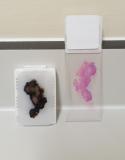Test Directory
FUS gene rearrangement
Containers - Adult

FFPE block / H&E slide / Pathology report
|
|
Laboratory Site
Old Dalkeith Road
Edinburgh
EH16 4SA
Transport arrangements
Referral specimens should be sent directly to Molecular Pathology at the above address (see transport recommendations). For patients with pathology specimens held within NHS Lothian there is no need to arrange transport of specimens.
How to request
Testing for NHS Lothian patients can be requested by email to molecular.pathology@nhslothian.scot.nhs.uk or by discussion with an NHS Lothian Pathologist. Referral requests may be accompanied by a completed request form or covering letter.
Please also refer to our detailed requesting instructions.
Availability
Monday - Friday. 09:00 – 17:00
Anticipated turnaround
Turnaround times will vary depending on the nature of the report required.
Individual FISH results should be available within 10 working days. See results.
Static information/disclaimer
This test is accredited to ISO 15189.
Please note, alternative methodologies may be used. Full details will be included in all reports.
General additional information
The RNA binding transcriptional activator FUS/TLS (fused in sarcoma/translocated in liposarcoma) is encoded by the FUS gene. FUS-DDIT3 fusions are characteristic of myxoid liposarcoma, FUS-CREB3L1 or FUS-CREB3L2 of low grade fibromyxoid sarcoma, and specific substitution mutations in FUS commonly associated with familial neurodegenerative diseases such as amyotrophic lateral sclerosis. Latterly, EWSR1-CREB3L1 fusions have also been described in the morphologically related sclerosing epithelioid fibrosarcoma, and FUS-KLF17 fusions have been observed in a proportion of myoepithelial tumours.
A positive FUS gene rearrangement result is considered to be supportive evidence where a pathological diagnosis of myxoid liposarcoma or fibromyxoid sarcoma is being considered.
FUS gene rearrangements are detected by break-apart fluorescence in-situ hybridisation (FISH) analysis. The method will identify a chromosomal rearrangement involving the FUS locus at 16p11, but not the specific gene fusion partner.
For clinical advice on appropriate investigations, please contact our Molecular Pathology team.